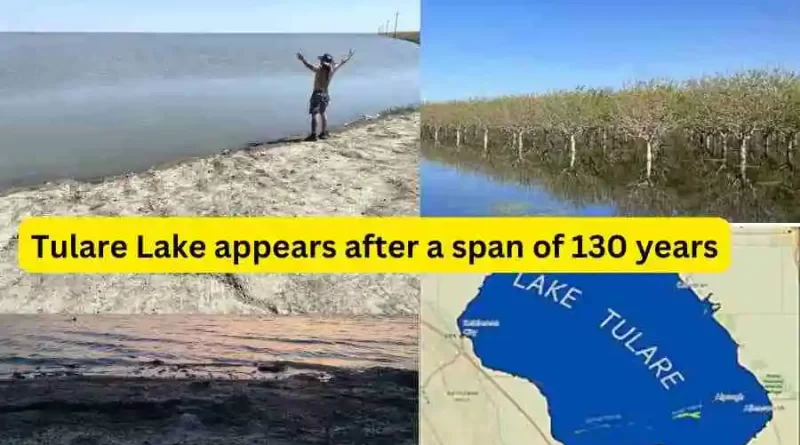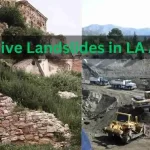Return of the Tulare Lake in California surprises people
A Stark Reminder of Nature’s Resilience and Humanity’s Impact
The re-appearance of Tulare Lake in America’s California region has evoked mixed responses from the local populace and the experts alike. The unexpected phenomenon occurred after a span of 130 years and inundated about 100,000 acres of farmland.
Due to unstoppable exploitation of the resources then and the development of human-made systems, the lake basin dried up. The land reclaimed thus was supplanted with trees and plants, followed by agriculture and fruit production. The said methodology converted inundated or deserted land into arable farmland.
Hundreds of canals were dug out and a vast system was created in the valley to divert the water away from Tulare Lake. “If people could drain that land, they would be granted ownership of parts of that land. So, there was a big incentive for white settlers to start doing that work,” said Underhill. Pistachios, almonds, cotton, and safflower were produced on these farmlands, but now everything has gone underwater.
The Sierra Nevada provided abundant water when abundant snowfall was recorded there, along with recurrent winter storms that refurbished the once vanished basin. A researcher working earlier at Northeastern University, Vivian Underhill, has been watching the latest development and says, “Tulare Lake was the largest body of fresh water west of the Mississippi River. It’s really difficult to imagine that now.”
Reappearing now in California’s San Joaquin Valley, the water body, often dubbed the “ghost lake,” has begun to support rich flora and fauna in and around it. Plants like the tule grass are found now growing on its banks and frogs are also seen hopping in and out of the tulare. Among fauna, the once vanished ducks, egrets, and other waterfowl are all over the place.
Despite the lake offering a welcome relief in the form of a blue expanse, Tulare Lake does little to lessen the effect of the hot weather. Some clouds higher up the lake don’t seem to offer any protection from the sun.
About 130 years ago, the Tulare Lake had about a system of 300 waterways supporting the traffic and thus sustaining the communities living around it. “Once, there was so much water that a steamship could carry agricultural supplies from the Bakersfield area up to Fresno and then up to San Francisco,” emphasizing its historical importance, Vivian explained.
In the early 1850’s and 1860’s, Tulare Lake began to disappear primarily due to the wrong policies of the then Californian authorities. They put the public land under private ownership, which actually belonged to the indigenous communities staying put there for centuries. The proclamation of the indigenous land as ‘public’ paved the way for the decline of the water body.
Yet, according to her, Fresno was a lakeside town and for the travelers visiting the area, its reappearance now sounds almost mythical. An absence of any natural outlet in the valley formed the lake when the water collected from the Sierra Nevada snowmelt. For the native American tribe Tachi Yokut, it was their lifeline and they called it ‘Pa’ashi.’
An environmental hazard
On the now-reappeared Tulare Lake basin, sit piles and piles of manure besides electrical wires, storage sheds containing fertilizers and chemicals and sharp farm machinery. So, a noticeboard on the lakeshore now warns the trespassers of the risks associated with venturing out in the lake. The presence of such materials at the bottom of the lake carries with it the risk of contamination. Both boating and swimming in its waters are thus risky.
According to Underhill, factors like the recent unabated snowfall in winter and unprecedented rains in California were the primary causes behind the formation of the lake. The changing weather patterns all over the world in general, and the US in particular, have only added to the melting of the snows at a faster pace.
She further says that the melting snow and rain still run towards the depression where the lake was once present. The local authorities are of the opinion that the phenomenon might take years before the water body reduces to some extent.
Lessons from the Tulare Lake formation
Often the world over, man has been pushing the frontiers towards the natural landscapes to reclaim the land for growing food. And California not being an exception, the same was done but at the cost of the native Indian American communities.
The result was a complete transformation of the whole valley and Underhill also lays stress on the colonial mindset of those early settlers. “It was a deeply settler colonial project that proceeded in fits and starts,” she says. Transformation of the water body then was a deliberately thought-out action by the then authorities who destroyed the natives as well as the natural ecosystems.
As per Underhill’s observation, the re-emergence of Tulare Lake holds tremendous lessons for humanity. Also, humans should deeply think about their ties with the land and the results that follow after excessive exploitation and alteration of the natural resources.
The lands, which are now under water, carry risks with the submerged machinery and chemicals sitting at the basin. As such, these hazards need to be addressed or else they might add their own share of woes to the issue.
Tulare Lake’s re-emergence has brought back species that were once thought to have vanished. And the changed landscape reminds one of how the region might have looked before farmlands came into existence.
With the reclaiming of the lands that truly belonged to the lake once, nature reminds us again what its resilience is like and also damaging aspects of any development. The return of the lake challenges people on the whole to reconsider their balancing vis-à-vis nature and subsequent guardianship of resources nature has to offer humanity.








